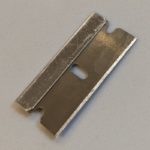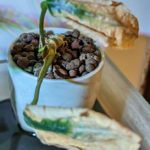Some collected wisdom from experiences with the downfall and subsequent rebuild of the low-tech open-topped Shrimphaus aquarium…
Open topped tanks should be made from glass, not acrylic

Open topped tanks will experience water evaporation. As that happens, mineral deposits will be left behind at the receding waterline. These mineral deposits can be easily scraped off using a single edged razor blade but only if the tank is made of glass. If the tank is made of acrylic, a razor blade will scratch the acrylic mercilessly and there won’t be a good way to get these mineral deposits off. With a closed-top tank, water does evaporate but mostly recondenses inside the tank; this means the water level doesn’t fall with time and you don’t get mineral deposits left behind that would need scraping. Even with off-the-scale-hard Cambridgeshire water, the closed top Fireplace Aquarium has never shown any mineral deposits at the waterline, but the open-topped Shrimphaus gets these forming almost straight away. Acrylic tanks can successfully be scraped down using a plastic credit card blank, and this works a treat for algae, but will be very tough going on mineral deposits.
Avoid uncleanable dead spaces
You will benefit greatly from not having any flat surfaces in the aquarium that can’t be periodically accessed for a good cleanout. Debris and rotting material can otherwise build-up in these pockets and potentially compromise the water quality of the whole aquarium. There also tends to be poor water flow in and around dead spaces further promoting accumulation of debris. These debris-collecting zones can arise from not-well-thought-out hardscape arrangements but can also arise from densely growing plants, for example, I once had a lot of organic debris trapped in a dense carpet of Marsilea hirsuta that eventually necessitated the whole carpet being torn out. Caves and complicated hardscape structures can seem like fun ideas and look interesting at first, but if you can’t get in there to clean them out there will inevitably be regret some day.
Keep hardscape away from the walls
Related to avoiding uncleanable dead spaces, if you have narrow gaps between hardscape and the walls of the aquarium, any algae that starts growing on either the walls or the hardscape in these spaces will be very challenging to remove without signficantly dismantling the hardscape setup. This is particularly problemic if light can get into these small spaces; it’s less of a problem if these gaps are dark all the time.
Epiphyes grow slowly – algae is a challenge
This is true for all slow growing plants actually, but epiphytes like the various Anubias and Bucephalandra species would be typical examples. There is a constant balance (battle) between plants and algae. Fast growing healthy plants can outcompete algae but with slowly growing plants, algae can start to get established on the leaves which then blocks light from the plant and competes for nutrients which further slows plant growth and damages plant tissues, which promotes more algae growth etc. It can work if there is a mix of fast and slow growing plants, and having an algae clean-up crew will also help, but having only slow-growing plants, or not enough plants generally, will make algae problems worse.
Too much light is bad
You might be surprised by just how little light is too much light. Plants are quite efficient at getting what they need from light so you don’t really need to unload on your aquarium with a photon cannon. Once you get more light than the plants can use, because they are growth limited by either CO2 levels, or nutrient levels, or just their inherent genetics, all the extra light can be used by algae. In my experience, “too much” light usually means the lighting is too intense, rather than the lighting duration being too long. As a result, it is very useful to have a lighting system where you can control the lighting intensity, which usually means a little more cost outlay than for simple non-dimmable bulbs on a timer.
Low humidity is difficult for aquatic plants

Maybe this could be filed under “obvious”, but most aquarium plants in the trade that can grow completely underwater, can also grow emersed out of the water but generally best with tropical rainforest type of humidity levels. I have struggled mightily to get underwater-capable aquarium plants to grow well in emersed form, with failures including Anubias nana ‘Coin’, Bucephalandra pygmaea ‘Bukit Kelam’, Echinodorus grisebachii ‘Tropica’ and Anubias coffeefolia. A few other people have had success growing aquarium plants in open-topped low(ish) humidity environments, but I’ve found that quite difficult. I keep trying…